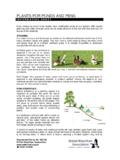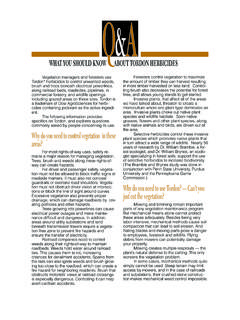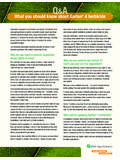Transcription of Welcome to Landscape Alternatives!
1 2007 Landscape alternatives , Inc. page 1 Landscape alternatives , Inc. offers a wideselection of high quality, nursery grownnative wildflowers, grasses and other lowmaintenance perennials. Our St. CroixValley nursery is easy to reach fromseveral major highways. A detail map ison the back page of this catalog. Pleasecall ahead to check on current strive to provide you the best in ..SELECTION,QUALITY,SERVICE,AND VALUE!SELECTION - We offer about 200different native plant selections to fitalmost any Landscape situation. Native means different things to different our native plants it means originallycollected within a 100-mile radius of theSt. Paul area. Occasionally we have tosupplement our stock and try to useregionally adapted species wherever wecan.
2 They naturally thrive under ourwinters and other local seasonalconditions. By using local-sourcewildflowers and grasses our customers arehelping also to reintroduce to our land theplants that actually used to grow - We are licensed and in-spected by the Minnesota Dept. ofAgriculture (lic. #20013973), certifyingthat our plants are healthy and properlygrown. We sell only top quality, nurserypropagated, actively growing container-produced know right away that our activelygrowing plants are healthy and assure high quality by providing thebest growing environment each speciesneeds. Container grown stock is economi-cal, convenient, easily established withminimal transplant shock - and readywhen you are! Because the entire rootsystem remains intact, you can plant anytime during the growing We specialize in workingwith our customers personally; right atour nursery.
3 You can depend on our manyyears of experience to help you determinethe best species and sizes for your strive to keep a complete selectionavailable all season long. Give us a call orstop by, we are always ready to assist youin planning your - Many people expect directfield seeding to be the most cost-effectiveway to establish wildflowers. However,the best designs, even for the very largestplantings, recommend using as manytransplants as possible. This is becausemany of the important native wildflowersare very difficult to germinate under grow each individual species to thebest size for transplant ability, maturity,and value. The containers are chosen togive the best root volume for the size andage of each plant.
4 Using our expertlygrown and matured wildflowers and grassplants in your project assures greaterdiversity and fast establishment. Whencorrectly established, most of the speciesin your prairie will bloom within oneyear!HOW TO CONTACT USTelephone: (651) 257-4460 Fax: (651) 257-4499 Web site: BUSINESS HOURSOur season runs typically from mid Aprilthrough October, depending upon theweather. We are closed on major April-JuneMon-Thursday 9-6:00 Friday 9-8:00 Saturday 9-6:00 Sunday 12-5:00 Late Summer/Fall July-OctoberMon-Saturday 9-5:00 Sundays 12-5:00 Winter November-MarchBy appointment only. Welcome to Landscape Alternatives! HarebellsCampanula rotundifolia 2007 Landscape alternatives , , Planting & Maintenance Guidepage 2 Design IdeasTraditional landscaping relies on a small number ofturf and ornamental plants.
5 This results in bland, cookie-cutter landscapes that require relativelyhigh levels of care. Too often, the plants are stressedand unhealthy. A major reason for this is the use ofpoorly adapted naturalized with native plants match theunique qualities of each plant to the specific require-ments of the site. They are distinctive, regionally ap-propriate, generally require less routine maintenance,increase biological diversity, attract wildlife, andprovide new habitat for relatively rare plants. In-creasingly, Landscape designers are looking for waysto include locally adapted native plants in their consider many things when planning alandscape. landscapes must fit the needs of people. Agood design will reflect both the human and the natu-ral aspects of the site.
6 Successful landscapes harmo-nize with their environment. They use resourceswisely and cause little disturbance to their surround-ings. It is easy to see, for example, that adjacent wa-terways should remain undisturbed by landscapingactivities. Good designers also consider the impacttheir plans may have on neighbors and their land-scapes. Successful designs reflect the culture of thesurrounding neighborhood. Like it or not, neighborsare part of our environment too. Common sense andsensitivity to the concerns of neighbors ensure a moreharmonious single solution is ever appropriate in all situa-tions. Naturalized areas are usually combined withmore tradtional Landscape elements. Native plants arerarely used exclusively.
7 Many non-native "intro-duced" plants are better suited to certain many people, turfgrass lawns convey a sense ofcare and neatness. They certainly are better adaptedto continued trampling by children at plants, of course, excel in many situations too!They are used to reduce large lawns to more manage-able size and replace turf on steeply sloped or difficultto maintain areas. They provide an appropriate tran-sition from traditional landscaped areas to adjacentwoods and wetlands. They also make beautiful addi-tions to perennial gardens!A native plant community creates a vigorous, self-sustaining ground cover. A typical Landscape plantingshould contain at least 20 to 30 species. Each speciesin the community has some function.
8 Some are naturalfertilizer producers; others re-seed readily to fill inbare spots. Grasses form dense root systems that bindthe soil. Many attract wildlife. A diversity of speciesalso ensures that something is blooming; springthrough original prairies were very complex included many animals and microorganisms aswell as plants. In naturalized landscaping, it is morepractical to model the most visible esthetic and func-tional characteristics of the quantities are based on a density of ap-proximately one plant per square foot of gardenarea plus one per linear foot of front or other im-portant edge. Short grass plantings may needslightly more due to the smaller mature size of is most important to kill all existing perennialvegetation at the very beginning of mixed nature of a prairie plant communitymakes controlling these weeds later much moredifficult.
9 Cultivation by disking or rototillingwill only provide short-term control of a peren-nial grass like quackgrass. It will grow back laterfrom buried stem sections called non-selective herbicide such as Roundup (seeside bar) simplifies preparation. Make the firstapplication to undisturbed, existing vegetationabout two weeks before planting. Reapply, if nec-essary, 1 week before planting. Thick, tall vegeta-tion may need mowing and raking once dead. Un-less seed is also being used, there is usually noneed to cultivate before planting. The dead leavesand stems will act as a mulch to hold the soil andslow weed the grasses first, in a random manner, overthe entire area. This will assure an even groundcover. Flowers planted right on the edge tend tolose support and fall over onto adjacent shorter grasses like little bluestem up frontand along mowed turf borders for the forbs, placing the very shortestcloser to the edges.
10 Group the shorter flowerssuch as pasque flower to provide an directly into dead vegetation. A favoriteplanting tool of ours is a large wrecking bar madeof 1 inch steel bar stock. This "dibble" or punch isused to stamp approximately 2 inch deep holesinto the ground. It makes just the right sized plant-ing hole for a seedling plug. Press the plant plugsinto the holes. Soil augers, bulb planters, trowelsand spades can be used as well after planting. Supplement rainfallduring very dry or hot periods. Do not be alarmedat some signs of transplant shock. It is temptingand all too easy to over-water. Watering is notnecessary if the soil just under the surface prairie garden will not be static as it estab-lishes. It will naturally evolve to your uniquesite.




